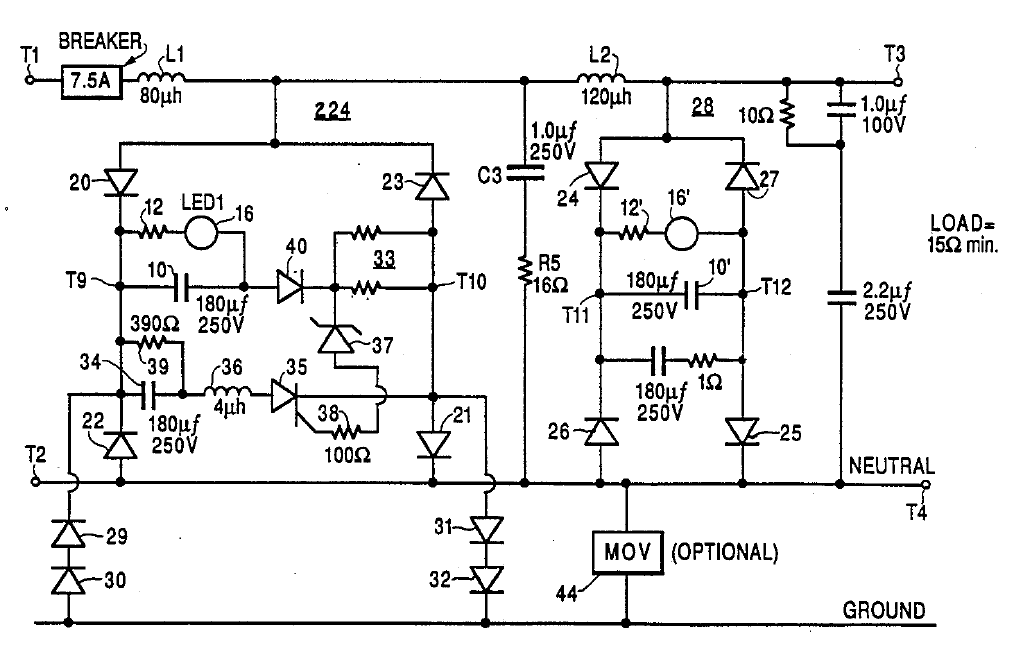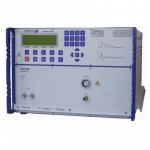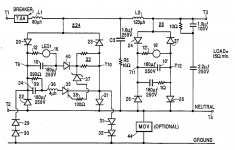Isn't that Demian's design, I'm sure he can help if so? I'm divesting a lot of old stuff and have several Hitachi MOSFET pairs from Hafler amps, you are welcome to them if they help no charge at all.
That's an amazingly kind offer and deeply appreciated. Although these are surprisingly tricky to test in circuit using a V-I trace* I'm reasonably, mostly, wishfully certain that they survived the failure incident (shorted speaker wire caused by breaking the rules). These Spectrals use the K135(?)s and its doppleganger, which may have been a variant of the Hafler's (going by memory, foolishly) K134, and its etc.
* Folks who've tried to quick-test big MOSFETs with a DVM will have already discovered that results will vary seemingly randomly depending on the probe's polarity at the last test - so you adapt, no biggie. A V-I curve tracer, usually running at line frequency 50/60 Hz, leaves the MOSFET's gate charge in an unknown random state. Took me several hours the first time to figure this out. Stubborn, but not bright.
Much thanks, as always, and I also saw you in a Burning Amp video last night. Great to see what people look like and to hear their voice. We're humans. It does matter that we look like humans, not just a disembodied voice. We're a tribe.
Chris
Last edited:
Yes lightning surge 1.2/50us voltage wave and 8/20us impulse current wave. Good to test a product, but not to test household wiring, especially not to confirm insertion of inductance into N or PE household wire - both is prohibited.
Yes lightning surge 1.2/50us voltage wave and 8/20us impulse current wave. Good to test a product, but not to test household wiring, especially not to confirm insertion of inductance into N or PE household wire - both is prohibited.
??? Huh? UL1449 is not a household testing spec.
It does allow me to know how much Ls is needed to reduce amplitude of peak impulse voltage before going to MOV; Extending the life of the MOV and reducing the likely-hood of MOV short/failure.
One could also use clamp-on ferrite over each A-V power cord.
-RNM
Last edited:
It might be time for me to once again share my enthusiasm about the series mode surge protectors sold by ZeroSurge (website). Their circuit design installs an inductor in series between the AC mains and the protected equipment, which slows the dV/dt and gives plenty of time for the surge clamper (monstrously large SCR) to turn on, so your downstream equipment does not see a fast risetime impulse. It's covered in a series of US Patents, the first of which is 4,870,528 attached below.
Circuit component "L1" is the series inductor and circuit component "35" is the monstrous SCR. I own three of these surge protectors, and am quite pleased with them.

_
Circuit component "L1" is the series inductor and circuit component "35" is the monstrous SCR. I own three of these surge protectors, and am quite pleased with them.
_
Attachments
Last edited:
The real weakness is the lack of common mode surge suppression. Also the L/C approach mostly spreads the surge. The SCR will absorb some surge and then pop the breaker.
I my experience the best solution is a purpose designed transformer for isolation and surge suppression. The transformer works as a bandpass filter and saturates on surges. However its large, heavy and expensive to implement. (Wait, High End Audio- how perfect. . .) E.G. Isolator Series 120V 1000W UL60601 1 Medical Grade Isolation Transformer 4 Hospital Grade Outlets (IS1000HG) | Tripp Lite Its not a normal isolation transformer. Tripplite seems to have bought this line of products from the older vendor PMI.
Or you could put in a dynamotor but those are really noisy.
I my experience the best solution is a purpose designed transformer for isolation and surge suppression. The transformer works as a bandpass filter and saturates on surges. However its large, heavy and expensive to implement. (Wait, High End Audio- how perfect. . .) E.G. Isolator Series 120V 1000W UL60601 1 Medical Grade Isolation Transformer 4 Hospital Grade Outlets (IS1000HG) | Tripp Lite Its not a normal isolation transformer. Tripplite seems to have bought this line of products from the older vendor PMI.
Or you could put in a dynamotor but those are really noisy.
The real weakness is the lack of common mode surge suppression.
Are you talking about an event which displaces all three wires (line, neutral, ground) in the same direction, by the same large (thousands of volts) amount? One point along the ground wire is connected to The Earth itself, so that little beauty will carry a helll of a current.
Depending on where you live the local electric utility may run the neutral (now called the grounded conductor) on the top of the wire runs. The idea is it will ground a lightning strike. Of course that doesn't really happen and when that kind of system is struck just about everything blows up.
Others have one of the hot wires on top. In those systems you might actually see half of everything blown up.
If you do have a very close strike then your safety ground might actually carry the damaging current.
Keep in mind the test for a safety ground only requires a resistance of less than a few ohms. At lightning currents it isn't much use.
I have a commercial product that is a pair of MOVs the connect to the two hot lines and take them to the neutral which is also connected to the safety ground inside that main panel.
All follows code as currently written.
So far it seems the MOVs actually do something. Before installing them every so often I would find some of my branch circuit GFCIs tripped after a storm. Much rarer event after the installation.
BTY I am licensed as an electrician in a few states! Required to install large sound systems.
Others have one of the hot wires on top. In those systems you might actually see half of everything blown up.
If you do have a very close strike then your safety ground might actually carry the damaging current.
Keep in mind the test for a safety ground only requires a resistance of less than a few ohms. At lightning currents it isn't much use.
I have a commercial product that is a pair of MOVs the connect to the two hot lines and take them to the neutral which is also connected to the safety ground inside that main panel.
All follows code as currently written.
So far it seems the MOVs actually do something. Before installing them every so often I would find some of my branch circuit GFCIs tripped after a storm. Much rarer event after the installation.
BTY I am licensed as an electrician in a few states! Required to install large sound systems.
There are several standard tests in UL1449 for surge. One is the common mode where the surge is between both the power leads and the safety ground. This is always more challenging because of the limited capacitance between them and ground. It limits the number of MOV's you can use and really limits noise filter caps.
One thing to keep in mind is that a real surge (cat 3) is 6KV with a 3KA current capability with a fast rise time. That number comes from real measurements of real surges. At the end of 100' of romex that surge will be on all the wires. MOV's are cheap and if not abused really do last forever. And they do really work like Zeners with really low on resistance. An MOV will get fried when hit with too much power. The 6KV at 3 KA for 100 uS is no problem but 240V on a 130V MOV will get you some pretty nasty smoke very quickly.
I think the best option is lots of surge suppressors distributed through the house and make sure all external connections (antenna, cable TV ethernet etc.) pass through the local surge box.
One thing to keep in mind is that a real surge (cat 3) is 6KV with a 3KA current capability with a fast rise time. That number comes from real measurements of real surges. At the end of 100' of romex that surge will be on all the wires. MOV's are cheap and if not abused really do last forever. And they do really work like Zeners with really low on resistance. An MOV will get fried when hit with too much power. The 6KV at 3 KA for 100 uS is no problem but 240V on a 130V MOV will get you some pretty nasty smoke very quickly.
I think the best option is lots of surge suppressors distributed through the house and make sure all external connections (antenna, cable TV ethernet etc.) pass through the local surge box.
Demian,
The other option, somehow I get the feeling there may be folks here who follow it, is to live in a cave and make your own power! 😉
The other option, somehow I get the feeling there may be folks here who follow it, is to live in a cave and make your own power! 😉
I think the best option is lots of surge suppressors distributed through the house and make sure all external connections (antenna, cable TV ethernet etc.) pass through the local surge box.
So then we must have what is the second best option here in Nl.
All power lines in residential areas (and way beyond) are burried and our power grid is well maintained. No one I know has ever invested a dime to protect gear against surges.
So it goes in many countries in the EU. America and Japan are very different, I was always looking at those spider net of wires in the streets 🙂
So it goes in many countries in the EU. America and Japan are very different, I was always looking at those spider net of wires in the streets 🙂
I'm reminded of the photos of telegraph lines from so long ago, so I had to look online - above-ground wiring started with data, not power!
Google Image Result for https://c8.alamy.com/comp/RB5CT0/telephone-and-telegraph-lines-new-york-city-victorian-engraving-1888-RB5CT0.jpg
AFAIK gas arrestors are lower tripped resistance than MOV but relatively slow, agricultural controller lightning protection I have seen has included MOV, Gas Arrestor and TVS Diode in parallel with the TVS possibly sacrificial....At the end of 100' of romex that surge will be on all the wires. MOV's are cheap and if not abused really do last forever. And they do really work like Zeners with really low on resistance. An MOV will get fried when hit with too much power. The 6KV at 3 KA for 100 uS is no problem but 240V on a 130V MOV will get you some pretty nasty smoke very quickly.
One site had copped serious blow ups several times until I got called in and found that the 800m far end of the floating balanced line (24V power plus signal consisting of coded dropped half waves) was contacted into wet ground despite the protection module/earthing electrode being 3" away......unbalanced line causing current transformer action and EHV blow ups of master controller every lightning hit on the property ?.
Sure.I think the best option is lots of surge suppressors distributed through the house and make sure all external connections (antenna, cable TV ethernet etc.) pass through the local surge box.
Dan.
Then there was the time we were replacing the sound system at a small American football field, the guys did a final hookup in a Monday and none of the far side loudspeakers worked properly. They had tested fine on Friday.
Turns out the folks who had installed the buried cable had grounded one wire. So when the weekend storm came in the loudspeakers worked quite nicely as lightning arresters. The inductors in the crossover were quite literally blown apart.
Just in case anyone was curious as to what happens to an inductor that passes a lightning surge.
I assume the bolt only hit one of the loudspeakers and it was the induced voltage that did in the rest.
Max don't use an umbrella when climbing the nearby tallest tree during a lightning event!
Turns out the folks who had installed the buried cable had grounded one wire. So when the weekend storm came in the loudspeakers worked quite nicely as lightning arresters. The inductors in the crossover were quite literally blown apart.
Just in case anyone was curious as to what happens to an inductor that passes a lightning surge.
I assume the bolt only hit one of the loudspeakers and it was the induced voltage that did in the rest.
Max don't use an umbrella when climbing the nearby tallest tree during a lightning event!
That's why you have brexit! 😀
There is a new verb: to brexit.
It is used to describe such a scene:
< YouTube >
cheers, Gerhard
^ 
"Last thing I remember, I was
Running for the door
I had to find the passage back to the place I was before
'Relax' said the night man,
'We are programmed to receive.
You can check out any time you like,
But you can never leave!'"

"Last thing I remember, I was
Running for the door
I had to find the passage back to the place I was before
'Relax' said the night man,
'We are programmed to receive.
You can check out any time you like,
But you can never leave!'"
- Status
- Not open for further replies.
- Home
- Member Areas
- The Lounge
- John Curl's Blowtorch preamplifier part III

